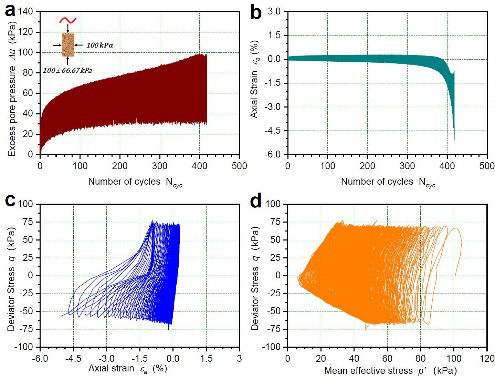Peng Xiao, Hanlong Liu, Armin W. Stuedlein, T. Matthew Evans, Yang Xiao. Effect of relative density and biocementation on cyclic response of calcareous sand[J]. Canadian Geotechnical Journal, 2019, 56:1849-1862
Keywords: Back propagation neural network; Multivariate adaptive regression splines; Pile drivability; Computational efficiency; Nonlinearity
High Lights:
Pile drivability models by both MARS and BPNN are presented.
Comprehensive comparison between MARS and BPNN in terms of modeling accuracy and computational efficiency etc.
MARS outperforms BPNN in computational efficiency and model interpretability.
Abstract:
Microbial-induced calcium carbonate precipitation (MICP) represents a promising approach to improve the geotechnical engineering properties of soils through the precipitation of calcium carbonate (CaCO3) at soil particle contacts and soil particle surfaces. An extensive experimental study was undertaken to investigate the influence of initial relative density on the efficiency of the biocementation process, the reduction of liquefaction susceptibility, and the cyclic response in biocemented calcareous soils. For this purpose, stress-controlled undrained cyclic triaxial shear (CTS) tests were carried out on untreated and MICP-treated calcareous sand specimens for different initial relative densities and magnitudes of biocementation. Improvement in the cyclic response was quantified and compared in terms of excess pore pressure generation, evolution of axial strains, and the number of cycles to liquefaction. The cyclic experiments show that MICP treatment can change the liquefaction failure mechanism from flow failure to cyclic mobility and can significantly change the excess pore pressure generation response of initially loose specimens. Scanning electron microscope (SEM) images indicate the CaCO3 crystals alter the characteristics of the sand particles and confirm the physical change in soil fabric that impacts the dynamic behavior and liquefaction resistance of MICP-treated specimens. Furthermore, the effect of biocementation was contrasted against the effect of relative density alone, and MICP treatment was shown to exhibit greater efficiency in improving the cyclic resistance than densification.
Resource:https://doi.org/10.1139/cgj-2018-0573
